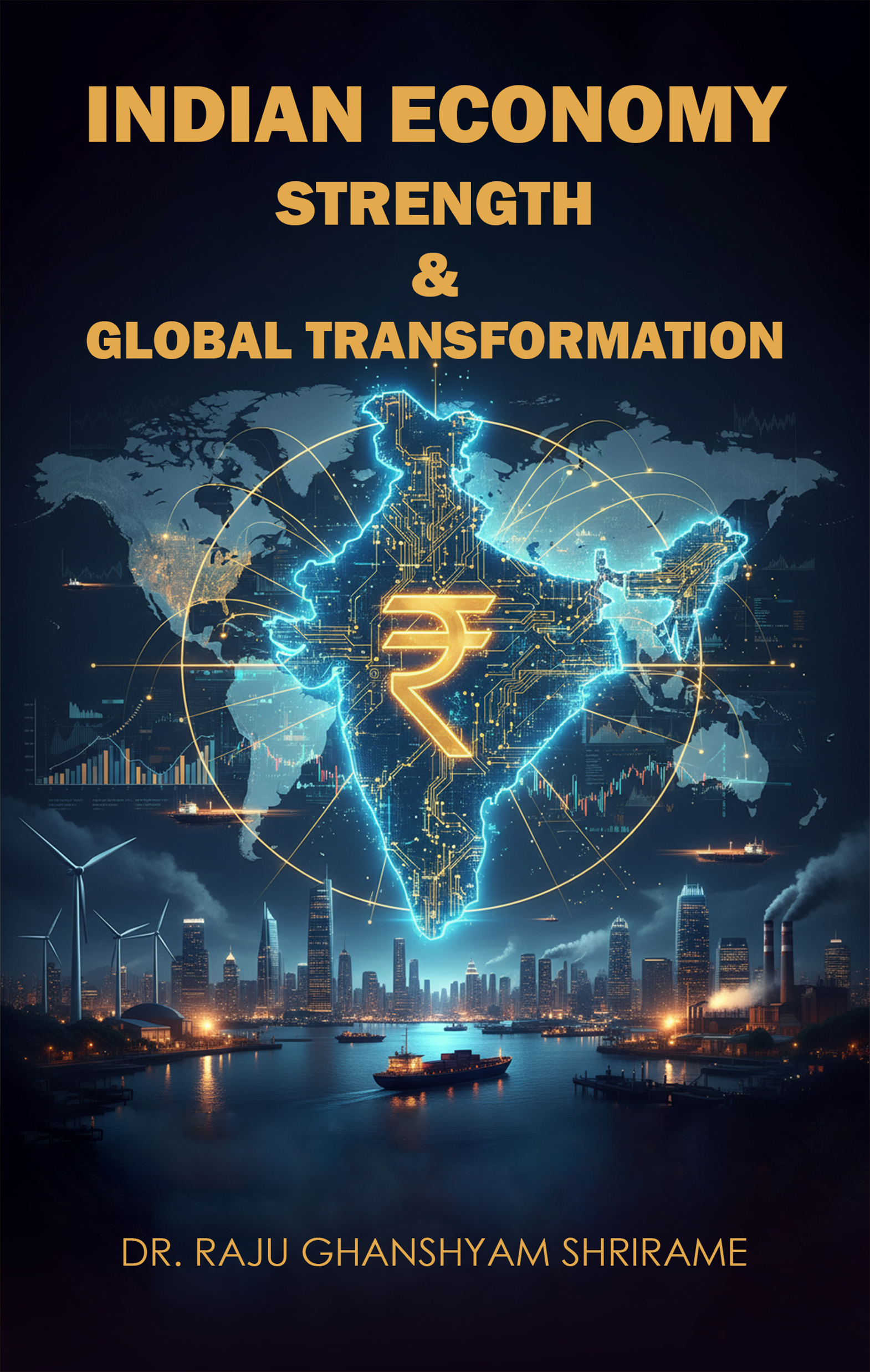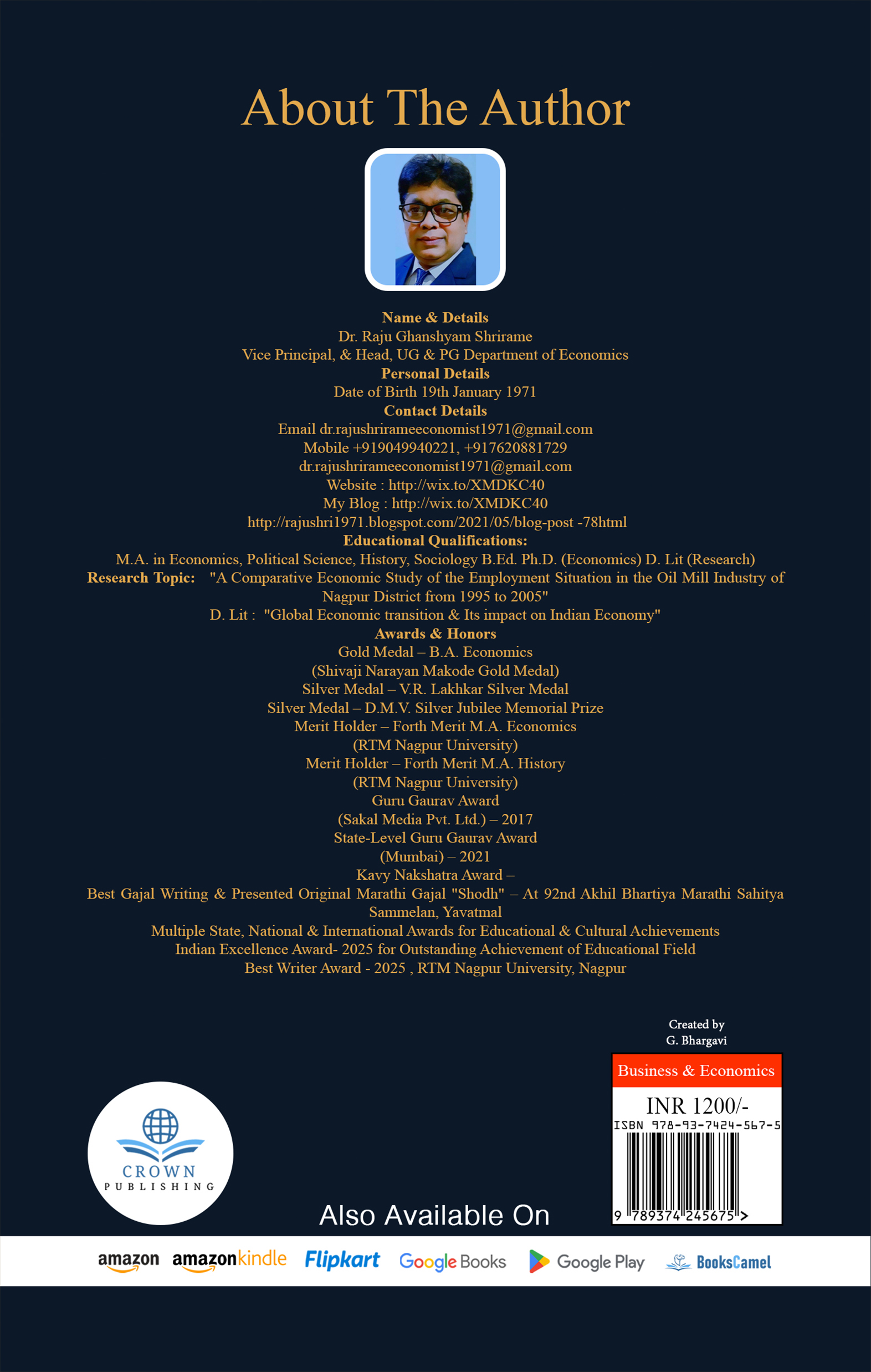Introduction
The Indian economy, one of the world’s most dynamic and diverse systems, has long fascinated economists, policymakers, and scholars across the globe. It is a unique blend of tradition and modernity, agrarian foundations and technological advancements, local markets and global trade linkages. The journey of India from being a primarily agrarian economy to one of the fastest-growing major economies in the twenty-first century exemplifies resilience, adaptability, and ambition. This book, Indian Economy: Strength and Global Transformation, seeks to analyze and narrate the remarkable story of India’s economic trajectory, while situating it within the broader framework of global change and transformation. The preface of a book holds a special purpose. It is not merely an introduction but a declaration of intent, a contextual foundation, and a guiding framework that provides readers with clarity about the objectives of the work. In presenting this preface, my aim is to prepare readers for a journey through the landscape of the Indian economy—its past struggles, present strengths, and future aspirations. This work aspires to provide clarity, insight, and direction at a time when India’s role in the global economy has never been more significant.
The Rationale for the Book
In recent decades, India has emerged as a central player in shaping global economic conversations. From the liberalization reforms of 1991 to the ambitious digital revolution of the 2010s, the country has repeatedly reinvented itself to meet the demands of an ever-changing global environment. The global financial crisis of 2008, the COVID-19 pandemic, geopolitical shifts, and the challenges of climate change have underscored the interconnectedness of economies. In such a context, analyzing India’s economic journey is not merely an academic exercise but a necessary undertaking to understand the future of global growth.
This book addresses critical questions:
1. What are the inherent strengths of the Indian economy?
2. How has India responded to global transformations in trade, technology, and geopolitics?
3. What lessons can other emerging economies learn from India’s experiences?
4. How does India’s economic development balance the dual demands of growth and equity, tradition and modernity, domestic needs and global responsibilities? These questions form the intellectual backbone of this work, and the preface seeks to highlight their relevance to readers worldwide.
Objectives of the Book
The overarching objective of this book is to provide a comprehensive account of the Indian economy’s transformation, while highlighting the sources of its strength. More specifically, the book seeks to:
 Trace the historical evolution of India’s economy from independence to the present day.
 Identify the structural strengths that support long-term sustainable growth.
 Examine the challenges of inequality, unemployment, regional disparities, and climate change.
 Situate India’s economy within the framework of globalization and global governance.
Project future trajectories for India as it aims to become a $7 trillion economy in the coming decades. By doing so, this book aspires to bridge the gap between academic theory and real-world policy practice.
The Global Context
No economy exists in isolation. The very term “global transformation†signifies the dramatic changes taking place worldwide. In recent years, the global economy has been shaped by multiple factors: technological disruptions, shifts in trade patterns, climate imperatives, geopolitical tensions, and the rise of Asia as the center of global growth. India’s role in this transformation is not peripheral but central.The preface must acknowledge that India’s economic story is deeply intertwined with global forces. Whether through foreign direct investment, trade partnerships, outsourcing, or digital innovation, India has become a key actor in global economic flows. Simultaneously, the challenges facing the world—such as sustainable development, carbon neutrality, food security, and equitable growth—require India’s active participation. This book seeks to highlight how India can both benefit from and contribute to these global transformations.
The Structure of the Book
The book is divided into several chapters, each addressing a crucial dimension of the Indian economy and its relationship with the world. Without revealing every detail here, the preface provides a broad outline:
 Historical Foundations – Understanding the pre-independence economy, the planning era, and the shift toward liberalization.
 Structural Strengths of the Indian Economy – Agriculture, services, manufacturing, and human capital.
 The Indian Economy and Globalization – Trade, investment, outsourcing, and India’s role in international organizations.
 Technology and Innovation – The IT revolution, digital transformation, and India’s startup ecosystem.
 Social and Economic Challenges – Poverty, inequality, unemployment, and regional imbalances.
 Sustainability and Green Growth – Climate change, renewable energy, and sustainable development goals.
 India’s Future Trajectory – Towards a $7 trillion economy and a global economic leader.
By combining historical analysis with forward-looking insights, the book aims to provide readers with both depth and vision.
Methodology and Approach
This book adopts a multidisciplinary approach, combining economics with history, sociology, political science, and international relations. The methodology involves both qualitative and quantitative analysis. Data from government sources, international organizations, and research institutions form the empirical foundation, while theoretical frameworks guide interpretation. The book also incorporates case studies of successful reforms, industries, and state-level initiatives to showcase India’s diversity. Importantly, the book does not shy away from critical evaluation. While highlighting strengths, it also confronts weaknesses and challenges with intellectual honesty. The aim is to provide a balanced account rather than an overly celebratory or pessimistic narrative.
Intended Readership
The book is designed for a diverse readership:
 Students and Academics – Those seeking an in-depth understanding of India’s economic journey.
 Policymakers and Practitioners – Decision-makers who can draw lessons from India’s successes and failures.
 International Scholars and Investors – Those analyzing India’s role in the global economy.
 General Readers – Individuals interested in understanding how India is shaping and being shaped by global transformations.The language has been deliberately chosen to maintain academic rigor while ensuring accessibility for a wider audience.
Acknowledgment of Challenges
In presenting this work, it is important to acknowledge that the study of an economy as large and diverse as India’s is inherently complex. Regional disparities, cultural diversities, and uneven development patterns make the Indian experience unique but also challenging to analyze. Furthermore, the rapidly changing global environment means that any conclusions drawn today may be tested by tomorrow’s realities. This book, therefore, does not claim to provide final answers but rather to initiate informed debate and reflection.
Contribution of This Work
The preface must highlight the originality and contribution of the book. Unlike many works that view India solely as an emerging economy, this book emphasizes India’s strengths—its demographic dividend, entrepreneurial spirit, democratic framework, and cultural richness—while also situating these strengths in the global transformation narrative. By focusing on both domestic resilience and international engagement, the book makes a dual contribution: it deepens understanding of the Indian economy while also enriching broader debates on globalization and development.
Personal Reflections
As the author, I must also share personal reflections that shaped this work. The Indian economy has always been a subject of fascination for me—not merely as a field of study but as a lived reality. Observing the transformations in rural and urban India, witnessing the rise of digital platforms, and engaging with policymakers and citizens alike have enriched my understanding. This book is the culmination of years of research, teaching, and reflection, and I offer it as a contribution to the ongoing conversation about India’s economic future.
Conclusion: Towards a Vision of Shared Prosperity
In conclusion, this preface sets the tone for the book’s central argument: that the Indian economy, while facing significant challenges, possesses inherent strengths that position it uniquely in the global arena. India’s transformation is not merely about higher GDP figures or ambitious targets; it is about inclusive growth, sustainable development, and global responsibility. The journey toward becoming a $7 trillion economy is not just a matter of numbers—it represents the aspirations of more than a billion people, the promise of equitable development, and the possibility of India contributing positively to global peace, prosperity, and progress.This preface, therefore, is an invitation to readers: to engage with the book not just as an academic text but as a narrative of hope, resilience, and transformation. The Indian economy is not a distant abstraction—it is a living, breathing reality that affects and is affected by the global order. As such, understanding its dynamics is not only an intellectual exercise but also a moral and practical necessity.
Date – 10/09/2025
Katol
Dr. Raju Shrirame
Prasad
Plot No. 33,
Thoma Lay Out, Panchwati West, Katol
Dist - Nagpur


 Continue With Google
Continue With Google

















